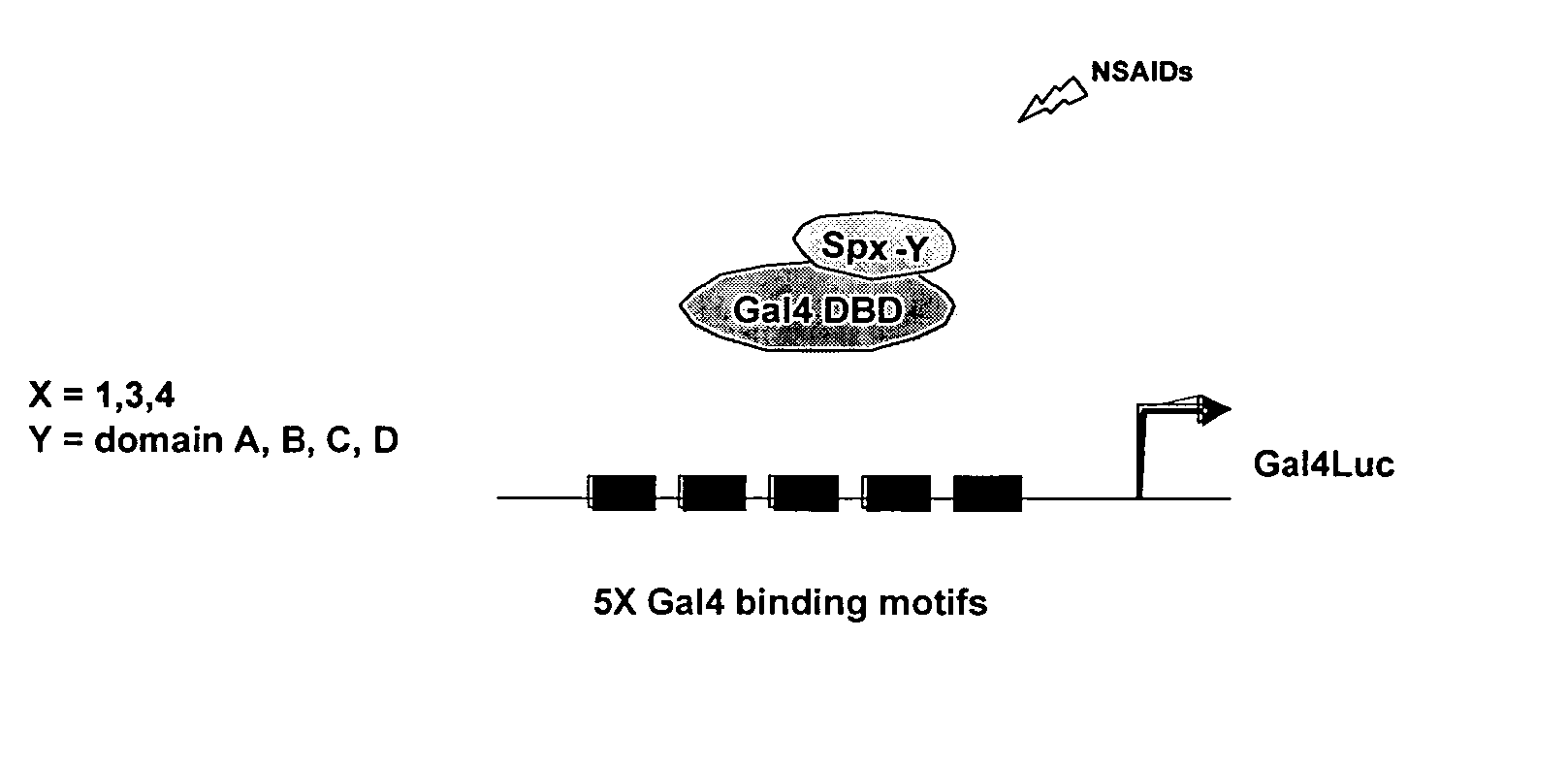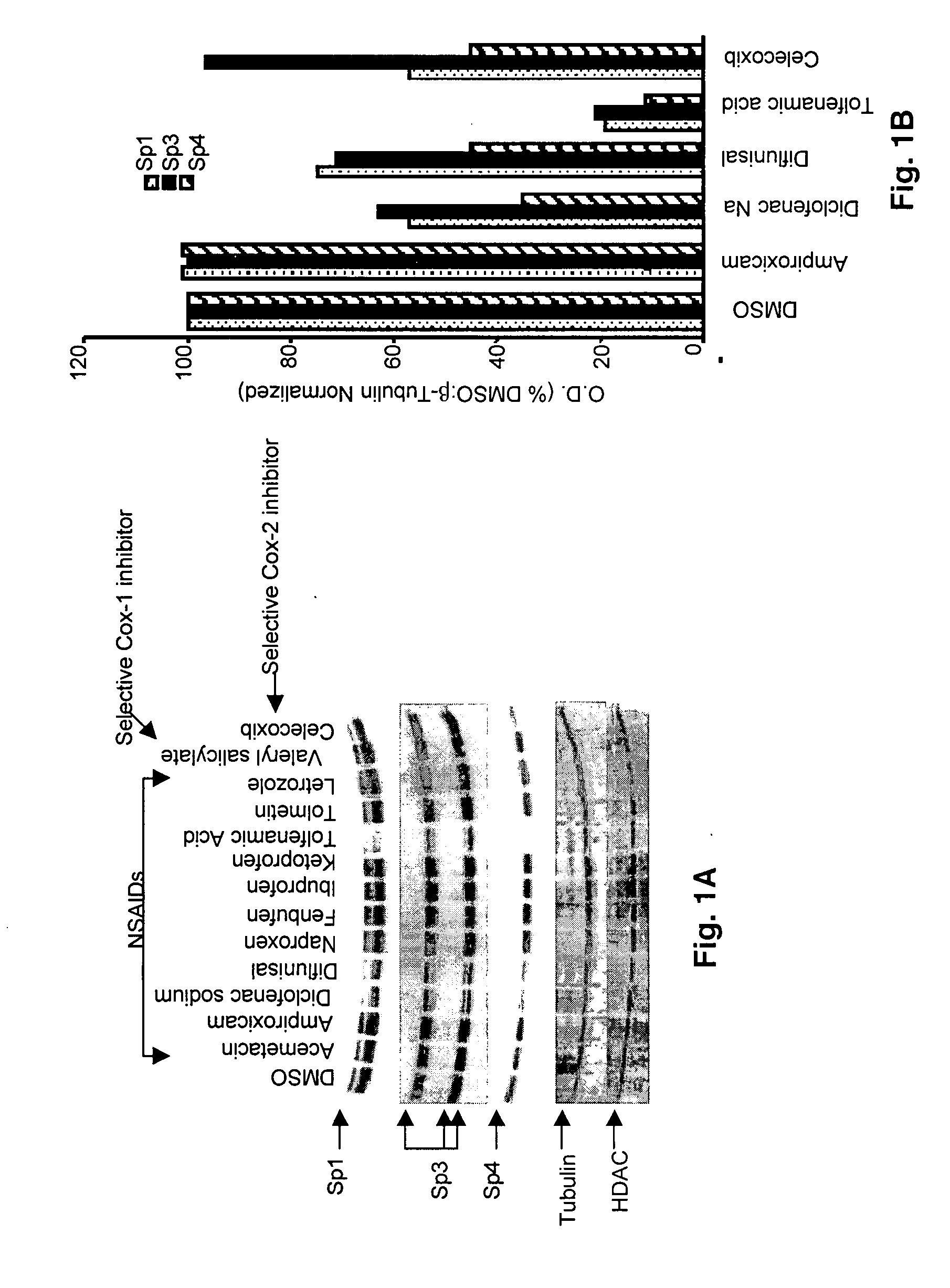Uses of diphenyl/diphenylamine carboxylic acids
a diphenyl/diphenylamine carboxylic acid and diphenyl/diphenylamine technology, applied in the field of cell signaling, can solve the problems of insufficient prior art cancer therapies, low median survival rate, and inability to provide minimal protection against breast cancer, so as to reduce the toxicity of cancer therapy.
- Summary
- Abstract
- Description
- Claims
- Application Information
AI Technical Summary
Benefits of technology
Problems solved by technology
Method used
Image
Examples
example1
Cell Lines Chemicals, Biochemical, Constructs and Oligonucleotides
[0056] Panc-1 cells were obtained from the American Type Culture Collection (ATCC, Manassas, Va.). L3.6p1 cell line was developed in at the M. D. Anderson Cancer Center (Houston, Tex.) and provided by Dr. I. J. Fidler. VEGFR1 promoter luciferase constructs were provided by Dr. Koji Maemura (Department of Cardiovascular Medicine, University of Tokyo, Japan). DME / F12 with and without phenol red, 100× antibiotic / antimycotic solution and lactacystin were purchased from Sigma Chemical Co. (St. Louis, Mo.). Collagen IV-coated plates were purchased from Becton Dickinson Labware (Bedford, Mass.). Diff Quik staining kit was obtained from Dade Behring (Newark, Del.). Fetal bovine serum was purchased from Intergen (Purchase, N.Y.). [γ-32P]ATP (300 Ci / mmol) was obtained from Perkin Elmer Life Sciences. Poly (dI-dC) and T4 polynucleotide kinase were purchased from Roche Molecular Biochemicals (Indianapolis, Ind.). Antibodies for ...
example 2
Transfection of Pancreatic Cancer Cells and Preparation of Nuclear Extracts
[0057] Cells are cultured in 6-well plates in 2 ml of DME / F12 medium supplemented with 5% fetal bovine serum. After 16-20 hr when cells are 50-60% confluent, reporter gene constructs are transfected using lipofectamine Reagent (Invitrogen, Carlsbad, Calif.). The effects of the selective NSAIDs on transactivation are investigated in Panc1 and L3.6p1 cells cotransfected with different VEGF constructs (500 ng). Cells are treated with DMSO (control) or with the indicated concentration of NSAIDs for 24 and / or 48 hr, then luciferase activity of lysates (relative to β-galactosidase activity) are determined. For proteasome inhibitor experiments, cells will be cotreated with 2 μM lacatacystin, and for EMSA assays, nuclear extracts from Panc1 and L3.6p1 cells are isolated as previously described, and aliquots will be stored at −80° C. until used (17, 19).
example 3
Western Immunoblot
[0058] Cells are washed once with PBS and collected by scraping in 200 μL of lysis buffer [50 mM HEPES, 0.5 M sodium chloride, 1.5 mM magnesium chloride, 1 mM EGTA, 10% (v / v) glycerol, 1% Triton X-100, 5 μL / ml of Protease Inhibitor Cocktail (Sigma)]. The lysates from the cells are incubated on ice for 1 hr with intermittent vortexing followed by centrifugation at 40,000 g for 10 min at 4° C. Equal amounts of protein (60 μg) from each treatment group are diluted with loading buffer, boiled and loaded onto 10 and 12.5% SDS-polyacrylamide gel. For VEGF immunoblots, 100 μg of protein are used. Samples are electrophoresed and proteins detected by incubation with polyclonal primary antibodies Sp1 (PEP2), Sp3 (D-20), Sp4 (V-20), HDAC (H-5 1), VEGF (a-20) and β-tubulin (H-235) followed by blotting with appropriate horseradish peroxidase-conjugated secondary antibody as previously described (17). After autoradiography, band intensities are determined by a scanning laser de...
PUM
| Property | Measurement | Unit |
|---|---|---|
| pH | aaaaa | aaaaa |
| concentration | aaaaa | aaaaa |
| volume | aaaaa | aaaaa |
Abstract
Description
Claims
Application Information
 Login to View More
Login to View More - R&D
- Intellectual Property
- Life Sciences
- Materials
- Tech Scout
- Unparalleled Data Quality
- Higher Quality Content
- 60% Fewer Hallucinations
Browse by: Latest US Patents, China's latest patents, Technical Efficacy Thesaurus, Application Domain, Technology Topic, Popular Technical Reports.
© 2025 PatSnap. All rights reserved.Legal|Privacy policy|Modern Slavery Act Transparency Statement|Sitemap|About US| Contact US: help@patsnap.com



